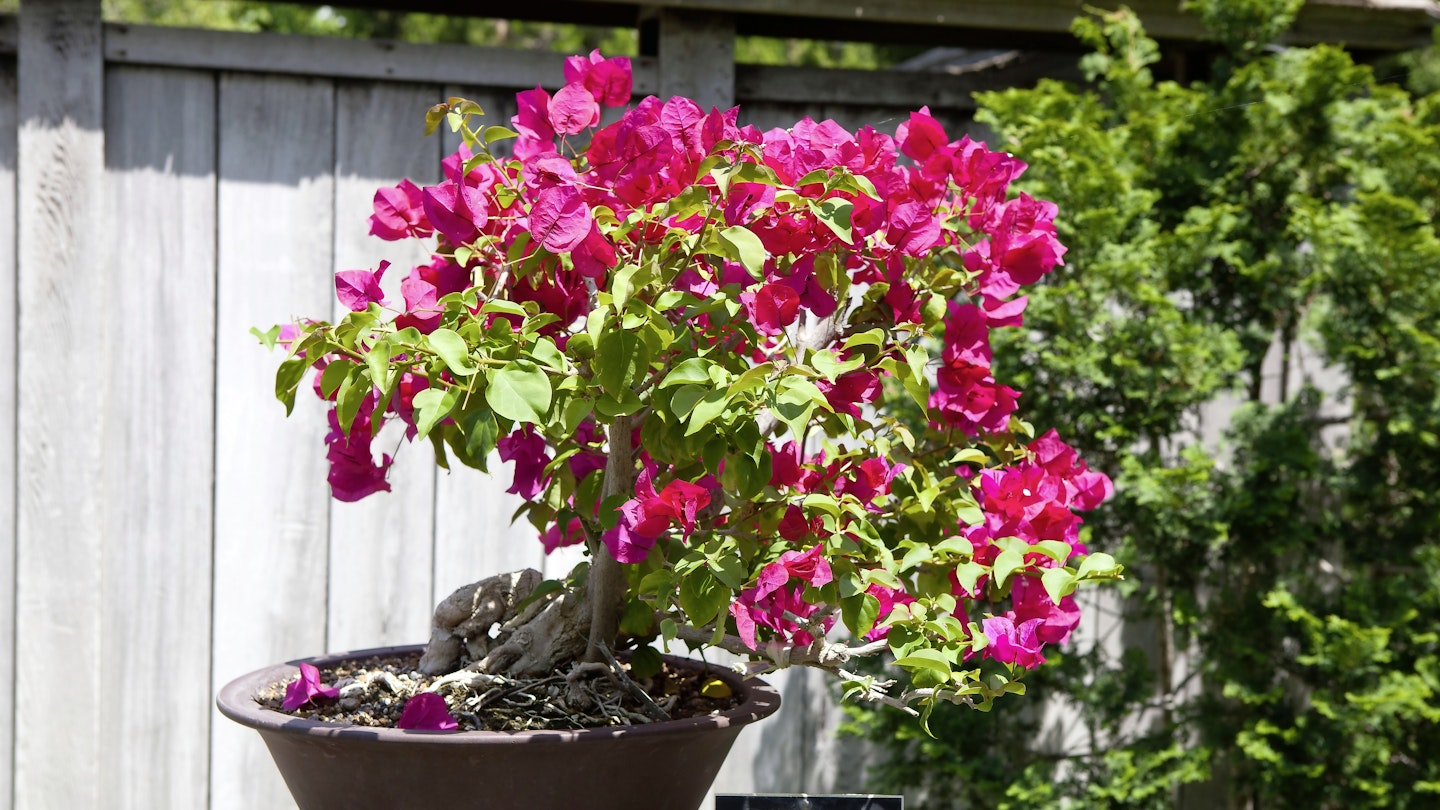In summer our thoughts turn to exotic flowers. Nothing is as vivid as expansive drifts of vibrant bougainvilleas in eye-popping colours from yellow and orange to the more common purples and pinks.
A vigorous climber with arching stems armed with unexpectedly sharp thorns, it can reach 5m (16ft) or more in frost-free climates. Though we can’t hope to match this in our cool climate, with a little care we can recreate a little bit of Mediterranean magic here at home, in the greenhouse, conservatory and even on the patio.
Up close and personal
In warm climates bougainvilleas grow as freely as brambles do here, flinging great arms of colour in all directions, covering the ground, scampering up walls and festooning slopes. Curiously, their colourful display is not provided by the flowers, which are small, tubular and creamy white, but their surrounding leaf bracts.
There are usually three colourful bracts that are arranged in a triangle, with one or two flowers attached to each of these. The flowers don’t last long but the bracts remain bright and cheerful, long before the flowers open and for weeks after the blooms shrivel up.
Facts on feeding
Although they grow in what seems to be dry soils, and they need sun and heat, it’s a mistake to treat them like cacti when growing them. Potentially large plants, bougainvilleas like plenty of water in growth and lots of feed.
Most are rather potbound when you buy them and can be put into slightly larger pots. Use a good compost containing some loam: John Innes No.3 is ideal.
Once growing, water frequently, though never allow them to sit in water, and apply a liquid fertiliser once a week right through to autumn.
In spring, especially as plants come out of dormancy, give a balanced feed that is relatively high in nitrogen to encourage strong stems. Then in June, switch to a high potash fertiliser which will help encourage flowering.
If you buy a plant in bloom, use a general fertilizer, which will encourage more shoots to grow, rather than a high potash fertiliser.
Siting success
It’s possible to grow them outside in only the mildest and warmest parts of the country, but everywhere else they need a sunny conservatory, sunroom or a greenhouse. Frequently sold on small wooden trellises, they can also be kept as houseplants on a sunny windowsill but they’ll eventually be too big and their thorn stems can play havoc with net curtains! A plant in bloom can be placed outside on a sunny patio where the bright bracts will give your garden a touch of the Mediterranean.
Year long colour
When temperatures in winter can be kept above 10c (50f) the plants can be evergreen and have some bracts through most of the year, but if kept cooler they’ll lose their leaves.
This will not damage the plants, which will be dormant in winter, when they should be kept almost dry and free from frost, in similar conditions to fuchsias and pelargoniums.
Pertinent pruning and care
Little pruning is needed in summer apart from cutting back the shoots that have finished flowering.
When lightly pruned, it’ll encourage sideshoots that should produce flowers later in summer. In late winter and early spring they can be pruned in a similar way to a rose bush, cutting away dead stems, any that are badly placed and reducing the length of strong shoots.
As with roses, very hard pruning may encourage strong stems that are unlikely to bloom except at the ends. This can be corrected by bending the stems over towards the horizontal.
Bougainvilleas are not especially prone to pests but aphids will attack the young shoot tips. In a greenhouse or conservatory they may be attacked by scale insects or mealy bug which both suck the sap and secrete sticky honeydew, which is often the first sign that plants are infested. Both can be controlled with a systemic insecticide.
‘Alba’ A more unusual variety with pure white bracts – arguably a little more elegant than the cerise pink ones.
‘California Gold’ This will bring a touch of the sun to your greenhouse with large yellow bracts that age to old gold.
‘Poulton’s Special’ You can be sure this will do well because it has an RHS Award of Garden Merit. The large, glossy leaves and vibrant deep pink bracts look the picture of health.
‘Raspberry Ice’ Colourful even when not in flower, this brilliant plant has variegated green leaves with broad buttery margins and deep cerise bracts.
Coloured collection available from J. Parker's****, or a wide range of individual selections from Westdale Nurseries
Get Your Facts Straight…
-
Bougainvilleas are now grown around the world but are actually native to South America.
-
The first European to see a bougainvillea was Jeanne Bare in 1766. She disguised herself as a man to take part in the voyage aboard the French expedition to circumnavigate the globe.
-
The plants were named after Louis Antoine de Bougainville who was the botanist on the ship.
-
The magenta B. buttiana was named after Mrs Butt who discovered it in Columbia. It is a natural hybrid.
-
Bougainvilleas make good indoor bonsai.
-
They are the national flower of Grenada.
